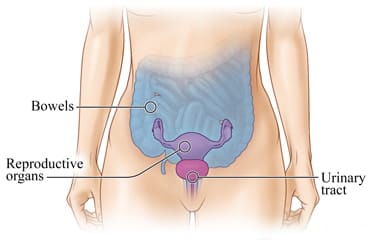Overview

Chronic pelvic pain is pain below the belly button that usually lasts more than 6 months. It can range from being mild to being so bad that it gets in the way of your daily activities and sleep.
Sometimes it's clear what is causing chronic pelvic pain. Other times it's not. The pain may come from your reproductive or urinary system, your bowels, or the muscles and nerves in the pelvis. And there can be more than one cause. Sometimes the brain and nerves become extra sensitive to the feeling of pain. This makes pain worse.
You and your doctor will work together to make a treatment plan. If there's a clear cause for your pain, your doctor will suggest treating it. Even if there's not a clear cause, your doctor can help you manage your pain well enough so that you can do the things that are important to you.
Follow-up care is a key part of your treatment and safety. Be sure to make and go to all appointments, and call your doctor if you are having problems. It's also a good idea to know your test results and keep a list of the medicines you take.
How can you care for yourself?
- Be safe with medicines. Read and follow all instructions on the label.
- If you are not taking a prescription pain medicine, ask your doctor if you can take an over-the-counter medicine.
- If the doctor gave you a prescription medicine for pain, take it as prescribed.
- Store your prescription pain medicines where no one else can get to them. When you are done using them, dispose of them quickly and safely. Your local pharmacy or hospital may have a drop-off site.
- If you have back pain, try lying down and propping up your legs by placing a pillow under your knees. When lying on your side, bring your knees up to your chest.
- Try using a warm water bottle, a heating pad set on low, or a warm cloth on your belly. Or take a warm bath. Don't go to sleep with a heating pad on your skin.
- Think about trying acupuncture, yoga, or massage. These may help some people. Or you can try relaxation techniques, such as breathing exercises or meditation.
- Be as active as you can be. It helps some people feel less pain.
- If your doctor asked you to keep a journal, track your symptoms, menstrual cycle, sexual activity, and physical activity. Track stressful events or illnesses. This can help your doctor find the cause or treat it.
- If you are given physical therapy exercises, it's important to do them.
When should you call for help?
Contact your doctor now or seek immediate medical care if:
- You have new or worse belly or pelvic pain.
- You have unusual vaginal bleeding.
- You have vaginal discharge that has increased in amount or smells bad.
- You notice new symptoms, such as:
- Fever or chills.
- Nausea or vomiting.
- Unexpected weight loss.
Watch closely for changes in your health, and be sure to contact your doctor if:
- You feel sad or anxious and it's not getting better.
- The pain is interfering with your sleep or daily activities.
Where can you learn more?
Go to http://www.healthwise.net/patientEd
Enter Z342 in the search box to learn more about "Chronic Pelvic Pain: Care Instructions".
Current as of: May 5, 2025
Author: Ignite Healthwise, LLC Staff
Clinical Review Board
All Ignite Healthwise, LLC education is reviewed by a team that includes physicians, nurses, advanced practitioners, registered dieticians, and other healthcare professionals.

